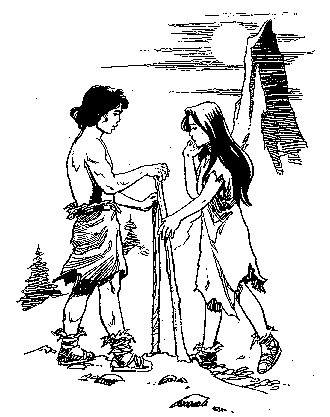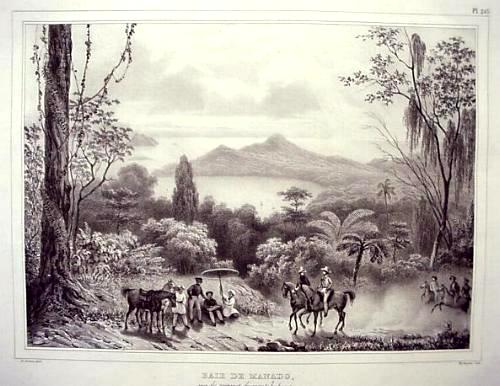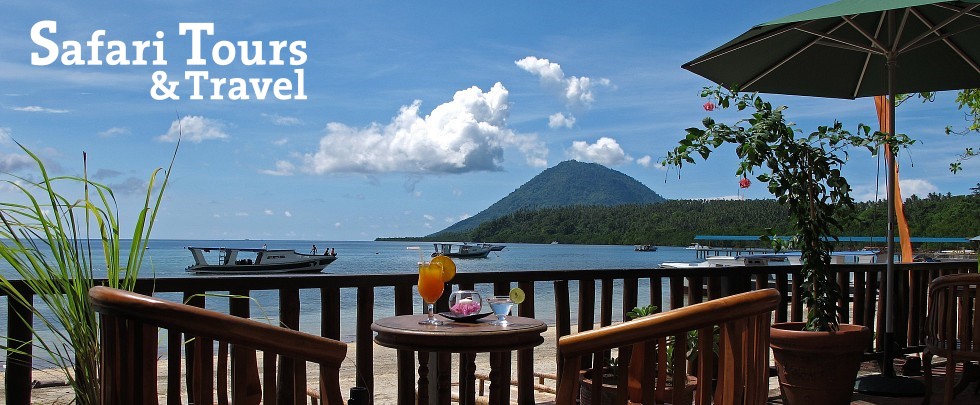A little explanation...
This used to be the website of the North Sulawesi Tourism Promotion Board (NSTPB), created in 2002. Unfortunately the NSTPB was a rather short-lived endeavour and after a while there was no more budget for keeping the site up-to-date. However, it remained online because of all the general information that it provided.
Now, almost 14 years later, a lot of the information on the site is simply too outdated to keep it online any longer. As anywhere else things in North Sulawesi have moved on and there are many better websites where you can get up-to-date information about everything related to North Sulawesi, like scuba diving, hotels, tours, shopping etc. However, when I created the website back in 2002 I spent a lot of time with collecting information about North Sulawesi's history from various sources. There might be others interested in reading about it, so I have decided to keep it online here.
Dr. Peter Blumtritt
January 2016
History of North Sulawesi
Ancient Times
Indonesia did not exist as yet during the Paleocene period (70 million years BC), the Eocene period (30 million years BC), the Oligacene period (25 million years BC) and the Miocene period (12 million years BC). Indonesia must have existed during the Pleistocene period (4 million years BC) when it was linked with the present Asian mainland.
Fossils of "Java Man" (Pithecanthropus Erectus) which date back some 500,000 years, were discovered near the village of Trinil in East Java by Dr. Eugene Dubois in 1809. This discovery was followed by other finds in later years which are evidence of Java's earliest inhabitants. Major migration movements to the Indonesian archipelago have been traced as far back as 3,000- 500 B.C. These first migrants were of Mongoloid stock from China and Tonkin and have been credited with introducing new Stone, Bronze and Iron Age cultures as well as the Austronesian language.
The existence of an ancient civilization in North Sulawesi is shown by the presence of the waruga stone sarcophagi, the oldest reportedly dating back as far as 900AD.
Indonesia came under the influence of a mighty Indian civilization through the gradual influx of Indian traders in the first century A.D., when great Hindu and Buddhist empires were beginning to emerge. By the seventh century, the powerful Buddhist Kingdom of Sriwijaya was expanding and it is thought that during this period the spectacular Borobudur Buddhist sanctuary was built in Central Java.
Moslem merchants from Gujarat and Persia began visiting Indonesia in the 13th Century and established trade links between this country and India and Persia. Along with trade, they propagated Islam among the Indonesian people, particularly along the coastal areas of Java, like Demak. At a later stage they even influenced and converted Hindu kings to Islam, the first being the Sultan of Demak. This Moslem Sultan later spread Islam westwards to Cirebon and Banten, and eastward along the northern coast of Java to the kingdom of Gresik. In the end, he brought the downfall of the powerful kingdom of Majapahit (1293-1520). By the 16th century, a powerful Muslim empire had developed on the Malay Peninsula, with its center at Melaka (Malacca).
North Sulawesi and the Minahasa people there never developed any large empire. In 670 AD the leaders of the different tribes, who all spoke different languages, met by a stone known as Watu Pinabetengan. There they founded a community of independent states, who should stay together and fight any outside enemies if they were attacked.
In their search for spices, the Portuguese arrived in Indonesia in 1511, after their conquest of the Islamic Empire of Malacca. They were followed by the Spaniards. Both began to propagate Christianity and were most successful in Minahasa/North Sulawesi and Maluku, also known as the Moluccas. However, it wasn't until the arrival of the Dutch that Christianity became the predominant religion of North Sulawesi.
Myths of Origin
Toar and Lumimuut
By Peter J.M. Nas
Published in Reimar Schefold (ed.), Minahasa: Past and Present, CNWS, Leiden, 1995, pp. 58-71.

"The mother was very handsome. Her name was Lumimuut and she was descended from the gods. Her beauty was fascinating and eternal youth her portion. And her son, named Toar, who had become a young man, left her to explore the world. At their farewell she presented him with a staff of equal length to hers. And she entreated him not to marry any of his relatives and therefore never to propose to a woman who was in possession of a staff of the same length.
After many years and long journeys the son returned. He met a beautiful woman, whom he desired to marry. In her he did not recognize his mother who had indeed remained eternally young, while she did not assume that this full-grown man was her son. Before entering into marriage, mindful of the wish of his mother when he had left her, the son laid his staff alongside that of his bride for comparison. Because of intensive use during his travels, however, his staff had been greatly worn down and was no longer of the same length. So there was nothing to prevent the marriage of the ancestors of the Minahasa people."
To the people of Sangihe-Talaud, their origins are closely related to the legend known as Modunde:
"There was a barren island, known today as Siau Island. To this island came a young, handsome and brave boy by the name of Medunde, supposedly on the back of a huge eagle, which in the Sangihe language is called gaghuda.
There were nine springs on this island. At these springs, Medunde saw nine beautiful sisters taking a bath. On seeing them, Medunde tried to approach them. However, as soon as the girls heard his footsteps, they disappeared into the sky.
One day, the girls returned and bathed at the same pools. When the girls were dressing Medunde began to play music on an instrument made of bamboo, a kind of trumpet called bansi. The girls were surprised to hear the sound. Simultaneously, they gathered their clothes and flew away. However, the youngest sister was seduced by that sound. To make a long story short, the young man and the girl fell in love and got married. Their children are said to be the original ancestors of the present people of Sangihe-Talaud."
(These nine springs still exist on Siau Island and are located between Ulu and Ondong. They used to be visited by married woman who wish to have children. The name of Siau island is taken from the nine springs, ake sio.)
Colonialism & Independence
The abundance of natural resources in Minahasa made Manado a strategic port for European traders sailing to and from the spice island of Maluku. At the time of the first contact with Europeans the sultanate of Ternate held some sway over North Sulawesi, and the area was often visited by seafaring Bugis traders from South Sulawesi. The Spanish and the Portuguese, the first Europeans to arrive, came to North Sulawesi via the port of Makassar, but also landed at Sulu island (off the north coast of Borneo) and at the port of Manado. Spain established a fort at Manado. However, the Spanish and Portuguese influence was limited by the power of Ternate.
The Portuguese left reminders of their presence in the north in subtle ways. Portuguese surnames and various Portuguese words not found elsewhere in Indonesia, like garrida for an enticing woman and buraco for a bad man, can still be found in Minahasa. In the 1560's the Portuguese Franciscan missionaries made some converts in Minahasa.
By the early 17th century the Dutch had toppled the Ternate sultanate, and then set about eclipsing the Spanish and Portuguese. They colluded with Minahasan rulers to throw out their European competitors. In 1677 the Dutch occupied Pulau Sangir and, two years later, the Dutch governor of Maluku, Robert Padtbrugge, visited Manado. Out of this visit came a treaty with the local Minahasan chiefs, which led to domination by the Dutch for the next 300 years.

J.S.C. Dumont D'Urville: "Baie de Manado"
The Dutch helped unite the linguistically diverse Minahasa confederacy, and in 1693 the Minahasa scored a decisive military victory against the Bolaang to the south, which by that time, like its neighbour Gorontalo, was a Moslem principality. The Dutch influence flourished as the Minahasans embraced the European goods and Christian religion. Portuguese activity apart, Christianity became a force in the early 1820s when a Calvinist group, the Netherlands Missionary Society, turned from an almost exclusive interest in Maluku to the Minahasa area. The wholesale conversion of the Minahasans was almost complete by 1860. With the missionaries came mission schools, which meant that, as in Ambon and Roti, Western education in Minahasa started much earlier than in other parts of Indonesia. The Dutch government eventually took over some of these schools and also set up others. Because the schools taught in Dutch, the Minahasans had an early advantage in the competition for government jobs and places in the colonial army.
The Minahasans fought alongside the Dutch to subdue rebellions in other parts of the archipelago, notably in the Java War of 1825-30. They seemed to gain a special role in the Dutch scheme of things and their loyalty to the Dutch as soldiers, their Christian religion and their geographic isolation from the rest of Indonesia all led to a sense of being 'different' from the other ethnic groups of the archipelago. Well-educated in mission and government schools, Minahasans were among the first colonists to seek employment and prestige abroad.
By the mid 1800s compulsory cultivation schemes were producing huge crops of cheap coffee for a Dutch-run monopoly. Minahasans suffered from this 'progress', yet economic, religious and social ties with the colonists continued to intensify.
The Japanese occupation of 1942-45 was a period of deprivation. It shattered the myth of Dutch superiority, as Batavia gave up its empire without a fight. Though initially welcomed as liberators in most parts of the archipelago, the Japanese gradually established themselves as harsh overlords.
In 1945 the allies bombed Manado heavily. During the war of independence against the returning Dutch that followed, there was bitter division between pro-Indonesian Unitarians and those favoring Dutch-sponsored federalism. The appointment of a Manadonese Christian, Sam Ratulangi, as the first republican governor of eastern Indonesia was decisive in winning Minahasan support for the republic.
Minahasans as Elite
Because Minahasans were enthusiastically Christian and well educated, they formed a minority in the wider Dutch Indies colony. This led to fewer racial boundaries than elsewhere. Minahasans were said to look, eat, and talk like Dutchmen. By the 1930s, however, other ethnic groups began to catch up and supplant Minahasans. Also, laws were passed which prevented colonial subjects, no matter how well educated, from gaining European status. These changes frustrated Minahasan aspirations to be treated like Dutchmen. Minahasan ambivalence was especially marked with reference to the Indonesian independence movement. On one hand, Minahasans feared independence was inevitable and thus it would be political suicide to "remain isolated". On the other hand, Minahasans feared "our tiny minority" would be "swallowed up" by the giant Indonesian nation. To allay their fears, most Minahasans rejected the more popular unitarian nationalism promoted by Sukarno - the nationalism of one nation - and embraced federalism, specifically the autonomy of each ethnic group or region. By 1942, educated Minahasans accepted that whatever their political future, it would be part of the future of Indonesia as a whole, though regional patriotism persists today.
A similar theme has been pursued in the Journal of Asian Studies, in an article entitled "Leadership and Social Mobility in Southeast Asian Society: Minahasa."
Newer History: Permesta to Now
With the conclusion of Indonesia's long and arduous struggle for independence most of its people believed there would be a rapid improvement of social and economic conditions. During the early years of independence some progress was made in this direction, most prominently in education, and for the time being at least Indonesian society did become somewhat more egalitarian than in the colonial period. But the degree of improvment fell far short of expectations, and disillusionment and frustration led increasingly to an understandable tendency to blame the central government in Jakarta for the inadequate measures taken to meet the expectations that had been aroused during the revolution.
As the young republic lurched from crisis to crisis, Jakarta's monopoly over the copra trade seriously weakened North Sulawesi's economy. Illegal exports flourished and in June 1956 Jakarta ordered the closure of Manado port, the busiest smuggling port in the republic. Local leaders refused and Jakarta backed down. As in Sumatra there was a general feeling that the central government was inefficient, development was stagnating and money was being plugged into Java.
In March 1957 the military leaders of both southern and northern Sulawesi launched a confrontation with the central government, with demands for greater regional autonomy. They demanded more local development, a fairer share of revenue, help in suppressing the Kahar Muzakar rebellion in Southern Sulawesi, and a cabinet of the central government led jointly by Soekarno and Hatta. At least initially the "Permesta" (Piagam Perjuangan Semesta Alam) rebellion was a reformist rather than a separatist movement.

Negotiations between the central government and the Sulawesi military leaders prevented violence in southern Sulawesi, but the North Sulawesi leaders were dissatisfied with the agreements and the movement split. Inspired, perhaps, by fears of domination by the south, the leaders declared their own autonomous state of North Sulawesi in June 1957. By this time the central government had the situation in southern Sulawesi pretty much under control but in the north they had no strong local figure to rely upon and there were rumors that the USA, suspected of supplying arms to rebels in Sumatra, was also in contact with the North Sulawesi leaders.
The possibility of foreign intervention finally drove the central government to seek military support from southern Sulawesi. Permesta forces were driven out of Central Sulawesi, Gorontalo, the Sangihe Islands and from Morotai in Maluku (from whose airfield the rebels had hoped to fly bombing raids on Jakarta). The rebels' few planes (supplied by the USA and flown by Filipino, Taiwanese and US pilots) were destroyed. US policy shifted, favoring Jakarta, and in June 1958 central government troops landed in North Sulawesi. The Permesta rebellion was finally put down in mid-1961.
The effect of both the Sumatran and Sulawesi rebellions was to strengthen exactly those trends the rebels had hoped to weaken. Central authority was enhanced at the expense of local autonomy, radical nationalism gained over pragmatic moderation, the power of the communists and Soekarno increased while that of Hatta waned, and Soekarno was able to establish his "Guided Democracy" in 1959.
North Sulawesi prospered under the New Order Government of President Soeharto, which took office in 1967. Many of the economic reports (but few of the political reforms) sought by the Permesta rebels were implemented. The province has a tolerant, outward-looking culture and it will be interesting to see what the future holds after the recent implementation of Regional Autonomy, the very idea that Permesta fought for.
Permesta Rebellion - Timeline
1956
June: Government clamps down on smuggling in North Sulawesi.
1957
June: Rebel army officers in Manado declare autonomous state of North Sulawesi (beginning of Piagam Perjuangan Semesta, or Permesta, rebellion).
September: Various rebellious officers from Sumatra and Sulawesi meet in Padang to coordinate forces.
1958
February: Rebellious officers meet in Padang while Sukarno is in Thailand.
February 15: Rebels set up rival PRRI government (Pemerintah Revolusioner Republik Indonesia) at Bukittingi. Permesta rebels in Sulawesi join forces with PRRI. The USA promises secret aid to the rebels. Sukarno demands a hard response.
February 21: Air Force bombs Padang, Bukittingi, and Manado.
March: Army units from Diponegoro and Siliwangi divisions land in Sumatra and take Medan.
April: Padang falls to central government forces.
May: Bukittingi falls to central government forces, as does Gorontalo on Sulawesi.
May 18: US pilot Alan Pope is shot down over Ambon while secretly helping PRRI rebels.
June: Manado falls to central government forces.
1960
September: Sulawesi is divided into North Sulawesi and South Sulawesi provinces.
Last traces of "Zelfbesturen" or autonomy for local rulers are removed from the law.
1961
February: Remnants of "Permesta" guerillas in Sulawesi begin surrendering after offer of amnesty.
May 29: Last of Permesta rebels in Sulawesi surrender.
Barbara S. Harveys monograph Permesta - Half A Rebellion is recommended for all those who wish to read more about the Permesta in North Sulawesi.
"This work grows out of her long interest in Indonesia's political development and a recent focus, involving substantial periods of field research, on the political history of Sulawesi. She has done much to fill one of the major lacunae in modern Indonesian history, and readers will undoubtedly welcome her study not only for the light that it throws on this period, but also because it makes much more understandable the extensive political changes that followed."
George McT. Kahin
